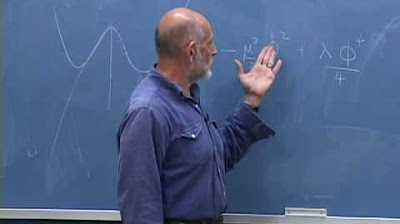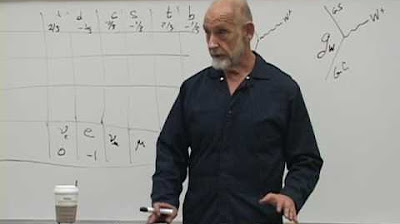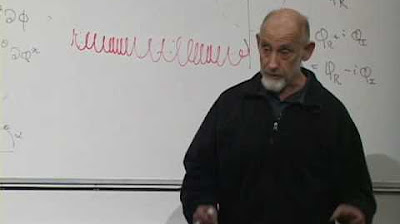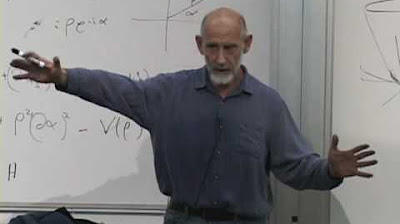Supersymmetry & Grand Unification: Lecture 9
TLDRThe transcript appears to be a lecture discussing advanced concepts in particle physics, focusing on symmetry breaking, supersymmetry (SUSY), and grand unified theories (GUTs). The lecturer introduces the idea of spontaneous symmetry breaking using the example of ferromagnets to explain how symmetry breaking can influence particle masses. They delve into supersymmetry, a theoretical framework that proposes a relationship between fermions and bosons, and discuss its implications for gravity. The lecture also touches on the mathematical formulations of SUSY, including the role of the superpotential and Goldstone fermions. Furthermore, the concept of vacuum energy and its impact on cosmology is briefly mentioned, including its potential role in the accelerated expansion of the universe. The discussion then shifts to the Grand Unified Theory, particularly SU(5), exploring the possibility of embedding the standard model symmetries into a more symmetrical group, and the implications for particle interactions and gauge bosons. The lecture is technical, aimed at individuals with a background in theoretical physics.
Takeaways
- 🧲 Ferromagnetism serves as a simple model to illustrate symmetry breaking, where the direction of magnetization in a ferromagnet represents a broken symmetry state.
- 💡 Spontaneous symmetry breaking can occur without an external influence, as seen in ferromagnets where the alignment of microscopic magnets (domains) breaks rotational symmetry.
- ⚛️ In quantum mechanics, the energy levels of an atom with a certain angular momentum are degenerate when there's no external magnetic field, but this degeneracy is lifted when a magnetic field is applied.
- 🌌 Supersymmetry (SUSY) is a proposed symmetry that relates bosons and fermions, and its breaking can have significant implications for the masses of particles.
- ⚖️ The Goldstone bosons arise as a consequence of spontaneous symmetry breaking, and they are massless particles that appear in the spectrum of the theory.
- 🌟 The vacuum state in a supersymmetric theory can exhibit supersymmetry breaking, which can lead to a non-zero vacuum energy and the presence of massless fermions, known as Goldstone fermions.
- 🔬 The superpotential in a supersymmetric field theory is a key quantity from which the ordinary potential energy can be derived, and it encodes the interactions and masses of particles.
- 🧵 The concept of a 'hidden sector' in SUSY is used to describe additional particles and fields that are not directly observable but are necessary for symmetry breaking.
- 📐 Group theory plays a crucial role in the standard model of particle physics, and the SU(5) Grand Unified Theory (GUT) is an example of a larger symmetry group that encompasses the standard model symmetries.
- 🔋 Vacuum energy, if non-zero, can lead to a cosmological constant that affects the expansion of the universe, and supergravity can play a role in reducing this vacuum energy.
- 🤔 The replication of particle families in the standard model and their unification within a larger symmetry group like SU(5) is a topic of ongoing research and speculation in theoretical physics.
Q & A
What is the significance of symmetry breaking in particle physics?
-Symmetry breaking is crucial in particle physics as it influences the energy levels of systems, which can be translated into the masses of particles. It is a fundamental concept that helps explain how particles acquire mass and how different forces might be unified at high energy levels.
How does a ferromagnet serve as an example of spontaneous symmetry breaking?
-A ferromagnet is an example of spontaneous symmetry breaking because it has a preferred direction of magnetization even though the laws of physics it obeys are rotationally symmetric. This means that in the absence of an external influence, the ferromagnet can point in any direction with the same energy, but it chooses a direction spontaneously, breaking the symmetry.
What are Goldstone bosons and how are they related to symmetry breaking?
-Goldstone bosons are massless particles that arise when a continuous symmetry of a system is spontaneously broken. They are the quanta of waves, like spin waves or magnons in a ferromagnet, that can propagate at no energy cost when the wavelength is very long. The existence of Goldstone bosons is a characteristic feature of spontaneous symmetry breaking.
What is supersymmetry and how does it relate to the standard model of particle physics?
-Supersymmetry is a proposed symmetry that relates two fundamental classes of particles: bosons, which have integer spins, and fermions, which have half-integer spins. In the context of the standard model, supersymmetry predicts the existence of a superpartner for each known particle, which could help explain phenomena such as dark matter and the hierarchy problem.
How does the superpotential in supersymmetry theory give rise to particle masses?
-The superpotential is a function of the superfields in supersymmetry theory. When the superpotential is non-zero, it can lead to a non-zero vacuum expectation value for the auxiliary field F in the superfield. This non-zero value for F, through its equations of motion, contributes to the mass terms for the scalar components of the superfields, effectively giving masses to the particles.
What is the cosmological constant problem, and how does supersymmetry breaking affect it?
-The cosmological constant problem is the discrepancy between the theoretically predicted value of the vacuum energy density and the much smaller observed value. Supersymmetry breaking can affect this by introducing a non-zero vacuum energy, which contributes to the cosmological constant. However, if supersymmetry is broken spontaneously, it can lead to a large positive vacuum energy that would cause an accelerated expansion of the universe, which is not observed.
How does the concept of a hidden sector in supersymmetry relate to the interaction between different particle sectors?
-In supersymmetry, a hidden sector refers to additional particles and fields that are not directly part of the standard model but are necessary for supersymmetry breaking. These hidden sector particles interact weakly with the standard model particles, causing only small splittings in the energy levels of particles and their superpartners. This weak interaction is analogous to a weak magnetic field affecting an atom, making the hidden sector 'hidden' in the sense that its effects are subtle and not easily observable.
What is the role of the Higgs mechanism in giving mass to gauge bosons?
-The Higgs mechanism is responsible for giving mass to gauge bosons, such as the W and Z bosons, in the electroweak theory. It works by breaking the electroweak symmetry spontaneously, which leads to the Higgs field acquiring a non-zero vacuum expectation value. This, in turn, interacts with the gauge bosons, providing them with mass.
How does the concept of a grand unified theory (GUT) simplify the standard model of particle physics?
-A grand unified theory (GUT) aims to describe the three fundamental non-gravitational forces (electromagnetic, weak, and strong) within a single, more symmetric framework. GUTs propose that at high energy levels, these forces unify into a single force, and the particles that mediate them can be part of a single, more symmetric representation of a larger gauge group, such as SU(5).
What is the significance of the group SU(5) in the context of grand unified theories?
-SU(5) is the smallest group that contains the standard model gauge group SU(3)_C x SU(2)_L x U(1)_Y as a subgroup. It is often used in grand unified theories because it can accommodate both quarks and leptons in a single multiplet, suggesting a deeper level of unification between these types of particles.
How does the representation of particles in the standard model fit into the SU(5) grand unified theory?
-In the SU(5) GUT, particles are arranged in representations that reflect their properties under the gauge transformations. The left-handed neutrino and electron, which only interact via the SU(2) group, are placed in the upper two slots of the 5-dimensional representation. The right-handed anti-quarks, which do not interact via SU(2), are placed in the lower three slots. This arrangement is determined by the requirement that the sum of the electric charges in a given SU(5) multiplet must be zero, stemming from the tracelessness of the SU(5) generators.
Outlines
😀 Introduction to Symmetry Breaking and Supersymmetry
The paragraph begins with an overview of symmetry breaking and its impact on the energy levels of systems, which can be translated into particle masses. It uses the example of ferromagnets to explain how symmetry breaking works and introduces the concept of supersymmetry breaking. The relationship between supersymmetry and gravity is also discussed, along with the implications for both.
🌌 Ferromagnetism and Spontaneous Symmetry Breaking
This section delves into the physics of ferromagnets, describing how they are composed of microscopic magnets that interact with each other. It explains how the alignment of these magnets can lead to different states such as ferromagnets, antiferromagnets, and non-magnets. The paragraph also discusses the effect of an external magnetic field on atomic energy levels and how a ferromagnet can exhibit spontaneous symmetry breaking, leading to a non-preferred direction of magnetization.
🤔 Goldstone Bosons and the Implications of Symmetry
The discussion moves to Goldstone bosons, emphasizing their role in spontaneous symmetry breaking. It describes how changing the direction of magnets can create waves, quantized as Goldstone bosons. The text explores the concept of massless particles and how they relate to long-wavelength excitations. The paragraph also ponders the experimental verification of spontaneous symmetry breaking within a ferromagnet.
🧲 Ferromagnetism as a Model for Supersymmetry
The paragraph uses the ferromagnet model to illustrate supersymmetry, highlighting the differences between explicit and spontaneous symmetry breaking. It discusses how a ferromagnet can simulate the effect of explicit symmetry breaking and how Goldstone bosons are related to the conservation of energy within a system exhibiting spontaneous symmetry breaking.
🤓 Supersymmetry and Gauge Forces
This section connects supersymmetry with gauge forces, discussing the interaction between the two and the resulting transformation of gauge bosons into massive particles. The importance of the vacuum state in supersymmetry is also covered, along with the concept of generators of symmetry and their action on the vacuum state.
🌟 Supersymmetric Quantum Field Theory
The paragraph provides a review of super symmetric quantum field theory, focusing on a single example involving a fermion and a boson field. It explains the properties of a chiral superfield and its components, and how integrating over these components yields the ordinary action for scalar and fermion fields. The paragraph also touches on the addition of interaction and mass terms to the Lagrangian.
🔍 Exploring Supersymmetric Lagrangians
This section delves into the mathematical aspects of supersymmetric Lagrangians, exploring how to derive ordinary Lagrangians from superfields. It discusses the integration over Theta variables and the extraction of terms with two Thetas, which are crucial for the Lagrangian's form. The paragraph also explains the concept of auxiliary fields and their role in simplifying the equations of motion.
📚 Supersymmetry Breaking and Vacuum Energy
The paragraph discusses the implications of supersymmetry breaking, particularly the effects on vacuum energy. It explains how a non-zero vacuum energy can lead to a cosmological constant and accelerated expansion of the universe. The text also touches on the influence of gravity on supersymmetry and how it can adjust the potential energy to result in a small cosmological constant.
🤨 The Role of Gravity in Supersymmetry
This section further explores how gravity affects supersymmetry, adding complexity to the theory. It outlines the potential issues with vacuum energy in the context of cosmology and how gravity can interact with supersymmetry to produce a viable model. The discussion also briefly touches on the Higgs phenomenon and its relation to particle spin states.
🔬 Particle Spin States and Supersymmetric Theory
The paragraph examines the relationship between particle spin states and supersymmetry, particularly focusing on massless particles like the photon and their transformation properties. It discusses how gauge bosons acquire additional spin components and how this relates to the Goldstone boson. The text also hints at the existence of a massive spin three-halves particle predicted by supersymmetry.
🧠 Group Theory and the Standard Model
This section introduces group theory as the basis for the Standard Model of particle physics, highlighting the importance of the SU(3) x SU(2) x U(1) group. It raises the question of whether a larger, more symmetric group like SU(5) could encompass the known particles and interactions, suggesting a potential unification of the fundamental forces.
🔬 The Generators of SU(5) and Particle States
The paragraph discusses the generators of the SU(5) group, explaining their role in defining the group's transformations and how they relate to the properties of elementary particles. It explores the mathematical structure of the generators and their commutation relations, providing insight into the underlying symmetry of particle physics.
🧲 The Assignment of Fermions to SU(5) Representations
This section focuses on assigning fermions to the representations of the SU(5) group, aiming to find a pattern that fits the known fermions into the group's structure. It discusses the distinction between left-handed and right-handed particles and their antiparticles, and how these can be labeled within the SU(5) framework.
🔋 Electric Charge and the SU(5) Quantum Numbers
The paragraph explores the concept of electric charge within the SU(5) model, explaining how the charge must be represented by one of the generators of SU(5) due to the tracelessness of the generators. It discusses the requirement for the sum of electric charges in a given multiplet to equal zero and how this leads to the specific assignment of particles to the SU(5) representation.
🧬 Completing the SU(5) Representation with Remaining Particles
The final paragraph suggests that the remaining particles not accounted for in the 5-dimensional representation of SU(5) can be placed into a 10-dimensional representation. It hints at the possibility of a deep underlying structure that allows for the complete assignment of all known particles to representations of the SU(5) group.
Mindmap
Keywords
💡Symmetry Breaking
💡Supersymmetry
💡Ferromagnets
💡Goldstone Bosons
💡Gravitons
💡Grand Unified Theories (GUTs)
💡Higgs Mechanism
💡SU(5)
💡Gauge Bosons
💡Quantum Field Theory
💡Cosmological Constant
Highlights
Stanford University discusses the concept of symmetry breaking and its impact on energy levels and particle masses.
A simple example of a ferromagnet is used to illustrate the principles of symmetry breaking.
The interaction between gauge forces and Goldstone bosons is explored, highlighting the conversion of gauge bosons to massive particles.
Supersymmetry breaking in a simple super symmetric field theory is explained, emphasizing its relationship with gravity.
The implications of supersymmetry and its breaking for gravity are discussed, including the effects on the fundamental properties of the universe.
The phenomenon of spontaneous symmetry breaking is introduced, detailing how it applies to particle physics and internal symmetry groups.
Goldstone bosons are explained in the context of spontaneous symmetry breaking, showing their role in long wavelength excitations.
The concept of vacuum states in quantum field theory is discussed, particularly in relation to symmetry breaking.
The mathematical framework of supersymmetry is reviewed, including the construction of super fields and super Lagrangians.
The generation of mass terms and interaction terms in supersymmetry through the super potential is explained.
The potential energy of the field in supersymmetry is derived from the super potential, illustrating the difference between super and ordinary potential energy.
The conditions for vacuum energy in supersymmetry are discussed, including the significance of a non-zero vacuum energy for cosmology.
The role of hidden sectors in supersymmetry is introduced, explaining how they contribute to symmetry breaking and the complexity of the theory.
The impact of gravity on supersymmetry is examined, particularly how gravity can influence the vacuum energy and the cosmological constant.
The Higgs phenomenon and its relation to the generation of mass for gauge bosons is discussed in the context of supersymmetry.
The Grand Unified Theory (GUT) is introduced with a focus on the SU(5) model, exploring the possibility of a more symmetric group encompassing the standard model symmetries.
The assignment of known fermions to the representations of SU(5) is detailed, showing how particles fit into the framework of the model.
The replication of particle families in the standard model and their implications for SU(5) symmetry are discussed.
Transcripts
Browse More Related Video

Supersymmetry & Grand Unification: Lecture 7

Lecture 10 | New Revolutions in Particle Physics: Standard Model

Lecture 6 | New Revolutions in Particle Physics: Standard Model

Lecture 7 | New Revolutions in Particle Physics: Standard Model

Lecture 8 | New Revolutions in Particle Physics: Standard Model

Supersymmetry & Grand Unification: Lecture 10
5.0 / 5 (0 votes)
Thanks for rating: